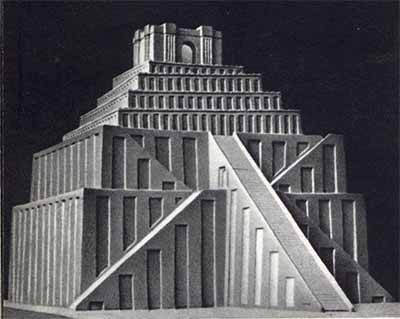The Bible Story of the Tower of Babel
Gate of Heaven

Tower of Babel history
The Tower of Babel has become the symbol of confusion because, according to Genesis, human pride, which was expressed by the very construction of this large building, was punished by God by the dispersion of men, forced to speak different languages and no longer the only language that was that of Adam. Even if the bible has placed the myth of the Tower of Babel in a dimension which does not allow to understand with clarity the historical aspects of this adventure, it should be noted that there are, in the cuneiform literature of Mesopotamia, concrete traces confirming the important symbolic role assigned to the ziggurats, these tall towers with smaller and smaller stories.
In an ancient text commissioned by King Nabopolassar, the monarch said these unforgettable words: “Marduk, the lord, ordered me, concerning the Tower of Babylon which, before my time, was in poor condition and was falling into disrepair, to provide the foundations within the lower world and to make its summit equal to the sky. I had terracotta bricks made. As if it were disproportionate rains from the sky or great torrents, I made transport by the Arahtu channel rivers of bitumen. I took a cane and measured the dimensions to give to the tower ... I placed under the bricks gold, silver and precious stones from the mountains and the sea. I had my royal portrait executed and had it installed in the foundations.”
Gate of Heaven
We will never know if the tower located in the center of one of the enclosures of Babylon and described by Herodotus was actually the mythical Tower of Babel. The Greek historian noted that this construction was “as long as a stadium, and just as wide” and that above it rose eight other towers: it was reached by a long staircase, halfway through which were found seats to rest during the tiring ascent.
The name of the Tower of Babel probably derives from the Akkadian language and its meaning corresponds to “door of the sky”; it should not be overlooked, however, that the Hebrew term of babel means “to confuse”. According to numerous studies, the tower was erected in the plain of Shinar, where the Bible locates it. Its designer and author would be Nimrod, the hunter, who reigned over several cities, including Babylon. Its construction dates back to 115 years after the Flood: it would have been about 90 meters high, but legend says that it was indeed “5,500 meters high and tens of meters in circumference, and it would have counted a hundred copper grids and 480 stories”.
Sumerian ziggurats

The Tower of Babel myth developed because of the presence of many ziggurats in the region of Aqar Quf, not far from Baghdad, as well as in Birs Nimrud and Kish in Iraq. The ziggurat is the Sumerian temple par excellence, symbolizing the mountain, or residence of the deities: it was built with mud bricks, clad in terracotta bricks and equipped with stairs allowing access to the temple placed at the top. Among the ziggurats still in condition today and which can give a vague idea of the effect that the Tower of Babel could have, let us quote that of Ur and Aqar Quf. The first is in southern Iraq and was built by King Ur-Nammu in 2100 BC with its four sides facing the four cardinal points and was dedicated to the lunar god Nanna (Sin); that of Aqar Quf is about 60 meters high and was built in the 15th century BC by King Kurigalzu.
The fascination exerted by these constructions is secondary only in relation to their mysterious message which still today worries the observer, certainly influenced by the words of the bible (Genesis) which made the Tower of Babel the symbol of the human pride fueled by the desire to equal and exceed divine power.









































































































































































































































































































































